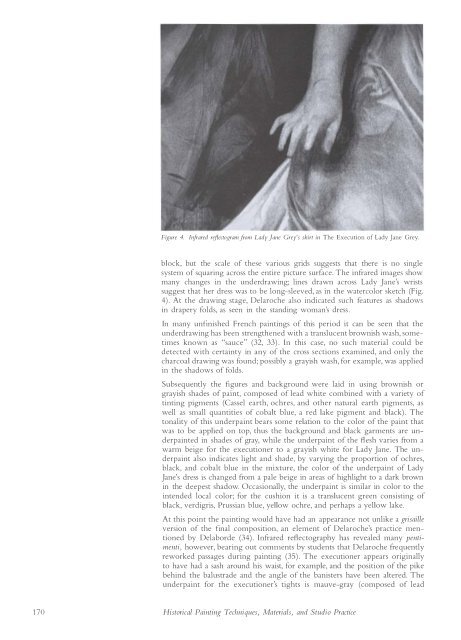Historical Painting Techniques, Materials, and Studio Practice
You also want an ePaper? Increase the reach of your titles
YUMPU automatically turns print PDFs into web optimized ePapers that Google loves.
Figure 4. Il1frared reftectogram from Lady jane Grey's skirt in The Execution of Lady Jane Grey.<br />
block, but the scale of these various grids suggests that there is no single<br />
system of squaring across the entire picture surface. The infrared images show<br />
many changes in the underdrawing; lines drawn across Lady Jane's wrists<br />
suggest that her dress was to be long-sleeved, as in the watercolor sketch (Fig.<br />
4). At the drawing stage, Delaroche also indicated such fe atures as shadows<br />
in drapery folds, as seen in the st<strong>and</strong>ing woman's dress.<br />
In many unfinished French paintings of this period it can be seen that the<br />
underdrawing has been strengthened with a translucent brownish wash, sometimes<br />
known as "sauce" (32, 33). In this case, no such material could be<br />
detected with certainty in any of the cross sections examined, <strong>and</strong> only the<br />
charcoal drawing was fo und; possibly a grayish wash, for example, was applied<br />
in the shadows of folds.<br />
Subsequently the figures <strong>and</strong> background were laid in using brownish or<br />
grayish shades of paint, composed of lead white combined with a variety of<br />
tinting pigments (Cassel earth, ochres, <strong>and</strong> other natural earth pigments, as<br />
well as small quantities of cobalt blue, a red lake pigment <strong>and</strong> black) . The<br />
tonality of this underpaint bears some relation to the color of the paint that<br />
was to be applied on top, thus the background <strong>and</strong> black garments are underpainted<br />
in shades of gray, while the underpaint of the flesh varies from a<br />
warm beige fo r the executioner to a grayish white for Lady Jane. The underpaint<br />
also indicates light <strong>and</strong> shade, by varying the proportion of ochres,<br />
black, <strong>and</strong> cobalt blue in the mixture, the color of the underpaint of Lady<br />
Jane's dress is changed from a pale beige in areas of highlight to a dark brown<br />
in the deepest shadow. Occasionally, the underpaint is similar in color to the<br />
intended local color; for the cushion it is a translucent green consisting of<br />
black, verdigris, Pruss ian blue, yellow ochre, <strong>and</strong> perhaps a yellow lake.<br />
At this point the painting would have had an appearance not unlike a grisaille<br />
version of the final composition, an element of Delaroche's practice mentioned<br />
by Delaborde (34). Infrared reflectography has revealed many pentimenti,<br />
however, bearing out comm.ents by students that Delaroche frequently<br />
reworked passages during painting (35). The executioner appears originally<br />
to have had a sash around his waist, for example, <strong>and</strong> the position of the pike<br />
behind the balustrade <strong>and</strong> the angle of the banisters have been altered. The<br />
underpaint for the executioner's tights is mauve-gray (composed of lead<br />
170<br />
<strong>Historical</strong> <strong>Painting</strong> <strong>Techniques</strong>, <strong>Materials</strong>, <strong>and</strong> <strong>Studio</strong> <strong>Practice</strong>


